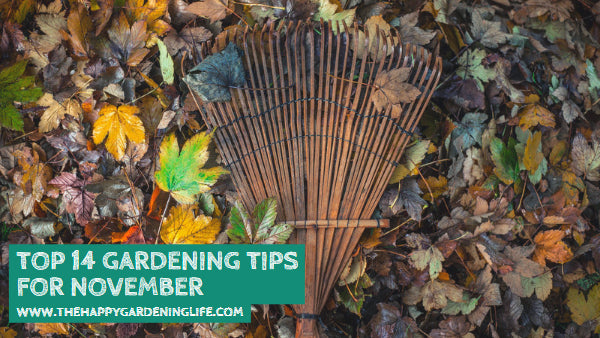
Top 14 Gardening Tips for November
Share
 Want to keep your garden in good condition throughout the holidays? Then doing some basic November gardening chores is an absolute must.
Want to keep your garden in good condition throughout the holidays? Then doing some basic November gardening chores is an absolute must.
November gardening involves a lot of preparation for winter, so most of the chores are centered around raking leaves, draining hoses, cleaning bird feeders, and the like. These are necessary if you want to successfully protect your vegetables and garden tools from the cold months.
Composting is also essential this November. Rather than throwing away those fallen leaves and other scraps, you can add them to your compost heap so you’ll have some good organic matter to use for the next growing season.
So whether you’re starting a winter garden or preparing your garden for the coming holiday season, be sure to apply these Top 14 November Gardening Tips to keep your plants and vegetables in prime condition!
For more organic gardening tips, go ahead and read through our various posts and pages here on The Happy Gardening Life. Happy browsing!
November Gardening Tips
1. Keep mowing your lawn as long as the grass is growing. Meadow voles and field mice will damage turf and nearby trees and shrubs if they have long grass for food and cover.
2. Drain your hoses and sprinklers and shut off hose faucets before low temperatures arrive.
3. Remove frozen plants from containers and hanging baskets and replace them with evergreen boughs, branches with colorful berries and interesting seed heads from perennials and ornamental grasses.
4. Spread clean straw, marsh hay or oak leaves over tender perennials, newly planted bulbs and strawberries before temperatures drop into the teens but after the soil surface has frozen.
5. Change the oil, sharpen blades, clean air filters and replace spark plugs on all of your gas powered equipment. You will have a head start on many spring projects if all of your equipment is ready to go.
6. It is too late for fertilizing your lawn and probably too late for seeding. If the weather is not too cold, sod installation may still be an option. Remove excess leaves from your lawn and use them as mulch or discard them.
7. Check potatoes in storage and remove any going bad.
8. Place a portable cold frame over rows of winter vegetables.
9. Compost is good for soil health, but only helps so much with weeds. Bark is very good for weed control, but avoid turning uncomposted bark into your soil (now or in spring) as it can limit the nitrogen that is available to your plants for some time. One to two inches of mulch is generally sufficient, and more than that is not better. Never place mulch so that it is touching the wooden stems of shrubs or trees.
10. Place mulch around berries for winter protection.
11. Cover rhubarb and asparagus beds with composted manure and straw.
12. Clean bird feeders, install squirrel guards and stock up on seed and suet. Birds add color and activity to your yard all winter and often stay in the spring to nest and raise their babies. If birds don’t appear even though you provide a good selection of food it may because your yard lacks shelter from cold winds and predators. Consider planting some pine, spruce or fir trees next spring.
13. Rake and compost leaves that are free of diseases and insects. Use mulches to prevent erosion and compaction from rain.
14. Order your heirloom seed packs for next year, if you haven’t already done so.
Article Source: Minnesota Landscape Arboretum, Portland Nursery, Oregon University State Extension
